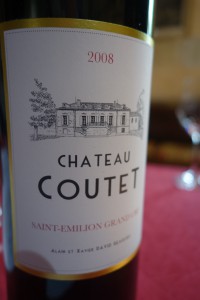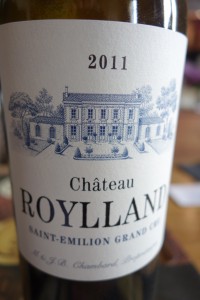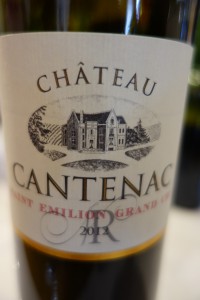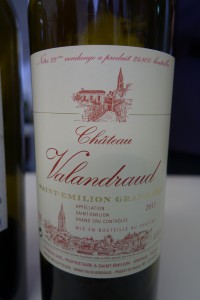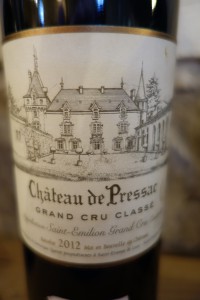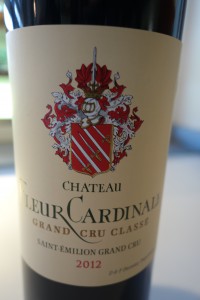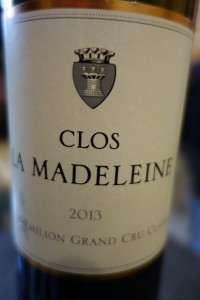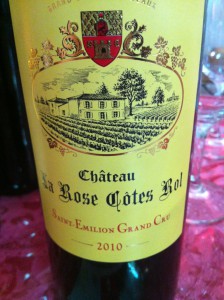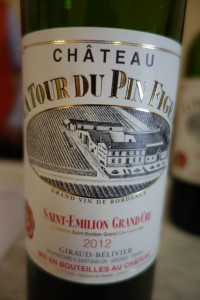I am a great fan of Portes Ouvertes in Bordeaux.
These “Open Days” occur when winegrowers in a given appellation welcome visitors to their château for a tour and tasting.
Open to the general public, these are wonderful occasions to discover all sorts of wines. They always take place over a weekend, and I have a strategy for making the most of them. First of all, I always go on the first day, Saturday, because there are far fewer people and it is much easier to talk with the winegrower. Second, while most people zero in on the famous estates with expensive wine, I go out of my way to visit the smaller, lesser-known ones to try to find the mouton à cinq pattes – an expression meaning “rare bird” – i.e. wonderful, under-appreciated, under-priced gems.
The 2016 Portes Ouvertes included 70 châteaux in Saint-Emilion and 11 in Lussac and Puisseguin-Saint-Emilion. That’s obviously more than you can shake a stick at, let alone visit in one day…
So, I contented myself with a modest 10.
I went visiting with young two American friends studying wine estate management in Bordeaux.
There are three English translations for grand cru: great growth, classified growth, or classed growth (in order of preferred usage). However, I do not translate these names in Saint-Emilion. Why? Because the classification in Saint-Emilion is a huge mess. For a start, only very clued-in people know that there is a difference between grand cru and grand cru classé, and most take them to mean the same thing… It seems as though every other château is a “grand cru” in Saint-Emilion, and the winegrower’s association is unable to say how many there actually are in the appellation! Furthermore, the last 3 official classifications have been shrouded in controversy. Lengthy court battles with numerous appeals and plenty of melodrama have cheapened the classification’s very raison d’être – as has the role of some of the appellation’s movers and shakers who were more or less judge and jury in their wine’s improved status… I’m thinking here in particular of Angélus and Pavie, which many Bordeaux lovers do not think deserve to have been bumped up.
The first visit of the day was Château Coutet, a 12.5 hectare estate (60% Merlot, 30% Cabernet France, and 7% Malbec, and 3% Cabernet Sauvignon) that obviously has nothing to do with the famous wine of Barsac. We were welcomed by M. Alain Beaulieu-David, whose family has owned the château for generations. I had never had the wine, so was very interested to try it. We sampled three vintages. The 2008 had noticeable bricking and a restrained, simple, cherry bouquet. The wine was thirst-quenching on the palate, but lacking in balance. The 2013 was better, with fresh rose petal and Pinot-like aromas. It proved to be a light pleasurable quaffer on the palate. The 2012 had an upfront, fruit-forward nose. It, too, was light in body and probably best enjoyed young. I saw it as the type of wine to appeal to the French market, as opposed to the full-bodied rich wines favored by English-speakers.
We then went to Château Roylland (80% Merlot and 20% Cabernet Franc), a 5-hectare estate belonging to Martine and Jean-Bernard Chambard, who bought it from the Adams, an American family who own Ch. Fonplégade, a cru classé. Roylland is located a stone’s throw from Angélus. The small cellars are impeccably kept. We tried two wines. The 2011 had a nose of beeswax, oak, and ripe fruit. It was thinner than expected on the palate and modern, but not to excess – New World meets Old. Nice textured finish. The 2009 had an understated, briary nose. It was better on the palate with good minerality, but considerable dryness on the finish, leading me to think it was overoaked.
We then went on to Château Cantenac (80% Merlot, 15% Cabernet Franc, and 5% Cabernet Sauvignon), which is located on the main road from Libourne to Saint-Emilion. This 15 hectare estate features an attractive 19th century château and a small range of wines from Saint Emilion as well as a Lussac Saint Emilion and a Médoc. I have enjoyed Cantenac on past occasions and always considered the wine good value for money. The 2012 Cantenac we tasted was no exception. The perfumed, cherry nose was a little dusty. It was big, straightforward, and quite open on the palate with toasty oak. This will be fun to drink in just 3 years. A fair deal at 15.50 euros a bottle.
The next stop was at a château I had never even heard of before: La Grâce Fonrazade. This 5-hectare estate was very much in the background for years, but that is in the process of changing. The new owners have seriously renovated the place and built a beautiful new tasting-function room. We sampled three wines. The 2011 Perverso (the estate’s 2nd wine) with an Italian-style label is so-named because the owners felt that you had to be pretty perverse and more than a little masochistic to embark on such an undertaking as they did! The wine initially made a very good impression on me, but on re-tasting there was simply too much oak on the palate. That is a pity because the taste profile featured many other attractive aspects. The 2011 grand vin had deep, subtle fruit on the nose. I was expecting an onslaught of oak, but this was not the case, except for some roast coffee aromas. However, sadly, oak did dominate the palate that otherwise had a silky texture and many good points.
The final wine was an oddball: a 2013 barrel-aged pure Sauvignon Gris. This was not only a rarity, but also happened to taste very good. Blind, I might have taken it for an Alsace. I bought three bottles. There is also a bit too much oak here too as well, but I think that will tone down over time. Also, many poor red wine vintages are good ones for dry white wines. This was the case in 2013.
Lunch was at a great bistro-type restaurant, Le Comptoir de Genès http://www.comptoirdegenes.fr/. This is in Saint-Genès-de-Castillon, quite close to Saint-Emilion. The restaurant belongs to Tony Lathwaithe, the Englishman who started an extremely successful wine firm that has turnover of 350 million pounds annually, just in the UK.
The restaurant serves hearty, simple food and you will probably find the world’s greatest collection of Côtes de Castillon wines there (they don’t sell any other kind), which you can buy either retail or have with your meal for a modest mark-up.
Next stop was ten-hectare Château Valandraud (70% Merlot, 20% Cabernet France, 5% Cabernet Sauvignon, 2% Carménère, 2% Malbec, and 1% unidentified…), , one of Saint-Emilion’s great success stories. Of course, whenever you succeed, there are always people ready to criticize you… Jean-Luc Thunevin has had his fair share of jealousy and criticism, which prompted him to release a generic Saint-Emilion called “Bad Boy” – which regularly sells out! Valandraud, universally considered a “garage wine”, is a sort of rags-to-riches story, leapfrogging the classification hierarchy to go directly from nothing to the Premier Grand Cru Classé (B) category.
We started off with the 2014 white (yes) Virginie de Valandraud (60% Sauvignon Blanc, 30% Sémillion, and 10% Sauvignon Gris), on sale for 29 euros a bottle. This was very pale with a fresh waxy, grassy nose. It had good acidity, well-integrated oak, and was better than expected. Then it was on to the red wines. We tried 2012 Esprit de Valandraud, 2011 Virginie de Valandraud (35 euros at the cellar door), and 2011 Valandraud (190 euros). All of these wines were strongly marked by barrel-ageing, especially the grand vin. This has a very fine lovely dark color and an ethereal cherry brandy nose with only a subtle touch of oak. The oak was, however, much more pronounced on the palate, where the wine showed chewy, velvety, and quite tannic. It definitely needs time to come together. Worth 190 euros? Not to this consumer.
Close by, also in Saint-Etienne-de-Lisse, is Château de Pressac with 36 hectares of vines (72% Merlot, 14% Cabernet France, and 12% Cabernet Sauvignon), one of the lucky wines to be promoted a grand cru classé. Pressac is your mind’s-eye wine château, perched atop a bluff overlooking a sea of vines. The treaty ending the Hundred Years’ War was signed here and parts of the structure date from the 13th century. The alternative name for Malbec – Pressac – also comes from this estate. We tasted the 2007 and 2009 vintages. We were disappointed with the former, but more indulgent with the latter. This had a good upfront black cherry bouquet and a little muskiness. It was fresh, round, and gummy/tarry on the palate, as well as a little hot on the finish. However, as much as I liked the aftertaste, the lead-up was wanting.
Château Fleur Cardinale, with 24 hectares of vines (70% Merlot, 20% Cabernet Franc, and 10% Cabernet Sauvigon), is located just down the hill from Pressac and in the same commune. There is a very good feel about the place. The vines all grow around the cellars in a single block and the cellars are very modern and tasteful. This estate was taken over by a family that made a fortune in Limoges porcelain. Dominique and Florence Decoster are young and clearly motivated. We tasted just one of their wines, the 2012. This had a lovely bright color as well as sour cherry, vanilla, and oak (but not too much) overtones on the nose. This is surprising considering that the wine is aged entirely in new barrels. The bouquet could have been more expressive, but the wine is still young. There is a lovely tang of terroir on the palate and the wine melts in the mouth. It shows good backbone and though very long is slightly dry on the finish, which features floral as well as fruity notes. Despite a few reservations, this was lovely and probably stands out as the best wine we tasted all day. It was on sale at 35 euros at the cellar door and I wish now I had picked up a bottle…
We next went to 2.2-hectare Clos de la Madeline (Merlot 76%, Cabernet-Franc 24%), the second smallest cru classé in Saint Emilion. This is not easy to find, and is close to Bélair-Monange, La Gaffelière, and Canon. I’ve very much liked the wine the few times I’ve had it. We were served the 2013, which had a good deep color and a nice ethereal/spirity nose with some roasted and toasty notes. The wine was round and soft on the palate, but showed good backbone and structure. Maybe a little austere, but definitely interesting and unquestionably a very successful 2013.
Then it was onto Grand Corbin (70% Merlot, 25% Cabernet Franc, and 5% Cabernet Sauvignon), a 29-hectare estate belonging to an insurance firm for public works companies who also own Ch. Cantemerle in the Médoc. I had never been to Grand Corbin before and rarely had their wine. The 2010 left a very good impression. The color was medium-deep with a thinnish rim. The nose revealed various nuances of mint, leather, plummy ripe Merlot fruit, and black fruit jelly. Rather old-fashioned in style, the wine was chewy and chunky on the palate with some tarry overtones. It was not tremendously long, but proved to be a fine vin de terroir with good acidity. Too young, but very promising. A nice discovery.
We proceeded to Ch. La Rose Côtes Rol with 10 hectares of vines (65% Merlot, 20% Cabernet Sauvignon, and 15% Cabernet Sauvignon). We tasted through the 2012 and 2009 vintages, plus the 2009 prestige cuvee called Ultime Atome. My notes are very critical, so the less said the better. However, the owners had invited friends from Burgundy, Sancerre, and Cognac and I fell prey to their wares. How to resist excellent red and white Sancerre from Domaine Pierre Martin, both at 10 euros a bottle? There was a wonderful atmosphere at the château, with singing and accordion playing, and it would have been nice to stay on, but we had to get back to Bordeaux for dinner, and there is always the issue of drinking and driving…
The end of the road was La Tour du Pin Figeac, an estate with 11 hectares of vines (75% Merlot and 25% Cabernet Franc). There used to be two châteaux with the exact same name. The Moueix family sold theirs to Cheval Blanc, who renamed it just “La Tour du Pin” for several years. After much testing years, part of this will be incorporated into Cheval Blanc, but the rest will be used to make, wait for it, white wine. Yup, there will be the Blanc de Cheval Blanc. Who’d have thunk?
Anyway back to the remaining La Tour du Pin Figeac, this has been owned for generations by the Giraud-Belivier family. We tried their 2012 and the 2004. The former had a dark, purplish color. The nose was very typical of Saint Emilion with plum and prune aromas. It seemed old-fashioned and there was a slight whiff of oxidation. The terroir came through on the palate with a chewy, grippy mouth feel and some tough tannin. The wine did not seem quite up to cru classé level unless it improves with age, but I’m sceptical. The 2004 had a fuzzy rim and looked quit old. It had a funky (bretty?), leathery nose. The wine was musky and mineral on the fairly dry palate.

